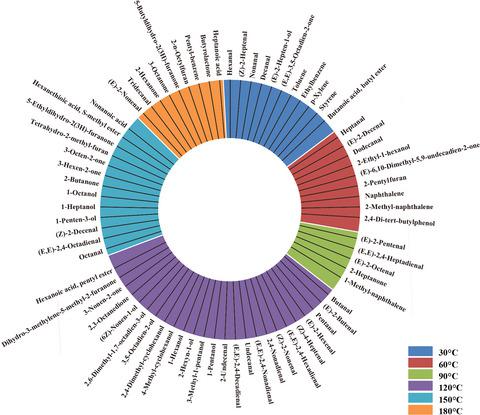当前位置:
X-MOL 学术
›
Food Sci. Nutr.
›
论文详情
Our official English website, www.x-mol.net, welcomes your
feedback! (Note: you will need to create a separate account there.)
Volatile compound profiling from soybean oil in the heating process
Food Science & Nutrition ( IF 3.5 ) Pub Date : 2020-01-14 , DOI: 10.1002/fsn3.1401 Lin Xiao 1, 2 , Chongwei Li 3 , Duo Chai 1, 2 , Yan Chen 1, 2 , Zhenyu Wang 1, 2 , Xianbing Xu 1, 2 , Yi Wang 4 , Yufeng Geng 1, 2 , Liang Dong 1, 2
Food Science & Nutrition ( IF 3.5 ) Pub Date : 2020-01-14 , DOI: 10.1002/fsn3.1401 Lin Xiao 1, 2 , Chongwei Li 3 , Duo Chai 1, 2 , Yan Chen 1, 2 , Zhenyu Wang 1, 2 , Xianbing Xu 1, 2 , Yi Wang 4 , Yufeng Geng 1, 2 , Liang Dong 1, 2
Affiliation

|
Soybean oil heating or cooking is a very complicated process. In order to better understand the composition of the volatile compounds from soybean oil during heating process, volatile profiling was carried out through vacuum‐assisted headspace solid‐phase microextraction combined with GC‐MS. As a result, a total of 72 volatile compounds were detected and identified during this process, including aldehydes (27), alcohols (14), ketones (10), furans (6), aromatic compounds (9), acids, and esters (6). And the forming temperature of each volatile was determined. Results show most of volatile aldehydes and alcohols were formed at 120°C leading to release off‐flavor largely, which was considered as a critical temperature point for the formation of soybean oil flavor during the whole heating process. Meanwhile, ketones and furans were formed at 150°C, and acids were detected at 180°C. The content of most volatile compounds increased significantly with the temperature raised. Simultaneously, results of principal component analysis demonstrate that flavor characteristics of soybean oil have a big difference between higher and lower temperature in the heating process.
中文翻译:

加热过程中大豆油的挥发性化合物分析
豆油加热或烹调是一个非常复杂的过程。为了更好地了解大豆油加热过程中挥发性化合物的组成,通过真空辅助顶空固相微萃取结合GC-MS进行挥发性成分分析。结果,在此过程中总共检测和鉴定了 72 种挥发性化合物,包括醛类(27 种)、醇类(14 种)、酮类(10 种)、呋喃类(6 种)、芳香族化合物(9 种)、酸类和酯类( 6).并测定了各挥发物的形成温度。结果表明,大部分挥发性醛类和醇类在120℃时形成,导致异味大量释放,被认为是整个加热过程中大豆油风味形成的临界温度点。同时,在150℃时形成酮和呋喃,在180℃时检测到酸。大多数挥发性化合物的含量随着温度的升高而显着增加。同时,主成分分析结果表明,大豆油在加热过程中,高温和低温的风味特征存在较大差异。
更新日期:2020-01-14
中文翻译:

加热过程中大豆油的挥发性化合物分析
豆油加热或烹调是一个非常复杂的过程。为了更好地了解大豆油加热过程中挥发性化合物的组成,通过真空辅助顶空固相微萃取结合GC-MS进行挥发性成分分析。结果,在此过程中总共检测和鉴定了 72 种挥发性化合物,包括醛类(27 种)、醇类(14 种)、酮类(10 种)、呋喃类(6 种)、芳香族化合物(9 种)、酸类和酯类( 6).并测定了各挥发物的形成温度。结果表明,大部分挥发性醛类和醇类在120℃时形成,导致异味大量释放,被认为是整个加热过程中大豆油风味形成的临界温度点。同时,在150℃时形成酮和呋喃,在180℃时检测到酸。大多数挥发性化合物的含量随着温度的升高而显着增加。同时,主成分分析结果表明,大豆油在加热过程中,高温和低温的风味特征存在较大差异。











































 京公网安备 11010802027423号
京公网安备 11010802027423号